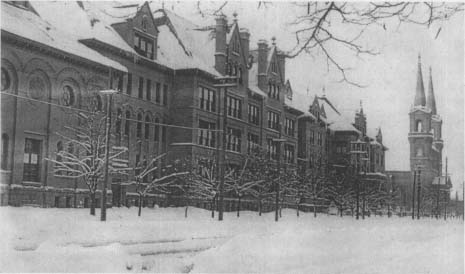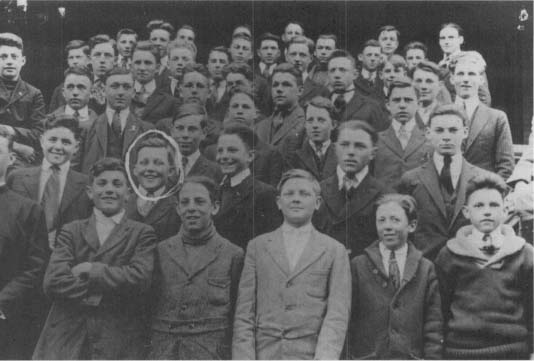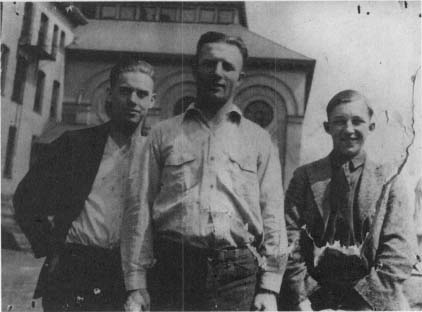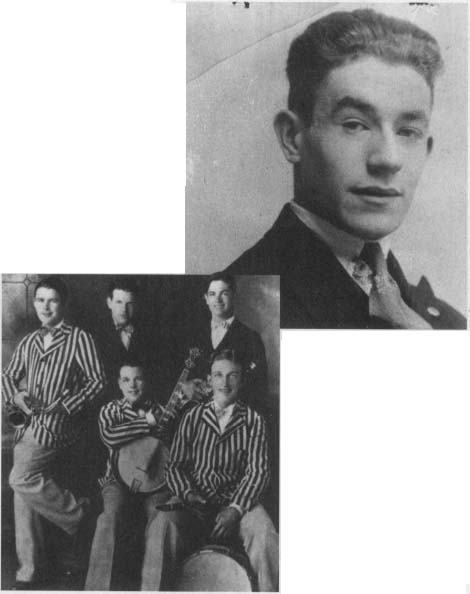Bing Crosby (21 page)
Authors: Gary Giddins

The infant Bing in Tacoma, with his aunt (Kate’s sister, Annie Walsh) on the steps of the Crosbys’J Street home.
Mark Scrimger Collection

Looking sporty at the new Sinto Avenue house in Spokane, Bing is hugged by his sister Mary Rose.
Mark Scrimger Collection

Six of the Crosbys on Sinto Avenue: left to right, Catherine, Kate (mother), Bing, Mary Rose, Harry (father), Ted.
Mark Scrimger Collection

The two-story clapboard house at 508 East Sharp Avenue, one block north of Gonzaga University and St. Aloysius Church.
Mark Scrimger Collection

Gonzagas main buildings, with the steeples of St. Aloysius to the right.
King Crosby Collection, Foley Center, Gonzaga University

Bing, circled, was the youngest in his high school class and looked it.
Bing Crosby Collection, Foley Center, Conzaga University

With Kate’s encouragement, Bing won seven swimming medals, including first place in diving and second place in the speed events.
He excelled at baseball, first at third base, then center field, and fantasized about playing professionally.
Mark Scrimger Collection

At a gathering in the Gonzaga University gym in 1919, Bing can be seen near the bottom, over the word
Bazaar.
Bing Crosby Collection, Foley Center, Gonzaga University

Bing learned to swim the hard way, among discarded logs at McGoldrick’s lumber mill on the northern bank of the Spokane River.
Mark Scrimger Collection

Mike Pecarovitch (center) was student council president and frequently shared the stage with Bing (right); by the 1990s Gonzaga
students could stroll through Pecarovitch Field and study at Crosby Library.
Bing Crosby Collection, Foley Center, Gonzaga University

Top: Frank Corkery, Bing’s boy hood friend and fellow glee club member, later became president of Gonzaga University.
Bing Crosby Collection, Foley Center, Gonzaga University
Bottom: The Musicaladers posed in a publicity shot for their best and longest engagement, at Lareida s Dance Pavilion (below),
originally an auto showroom. Left to right in striped blazers: Bob Pritchard, Clare Pritchard, Bing; in dark suits, Al Rinker,
Miles Rinker.
Mark Scrimger Collection

The speakeasy, which Bing remembered as The Swede’s, was a converted private house set back from the road and surrounded by
a fence. When the lookout saw Mildred, he let them into a large, crowded room with tables and bar and a small platform for
the piano and singer. The place, frequented by movie people, offered working girls as well as booze and song. When the spirit
moved her, the proprietress would sing a number or two. Red Norvo, who knew Jane Jones after Prohibition, when he was married
to Mildred and living in New York, described her as a large woman with a brassy style. Customers preferred what he called
“cooing types,” like Mildred or Tommy Lyman, a peripatetic singer-pianist who played chic clubs in New York and Europe and
liked to stop by Jane’s when he passed through town.
13
But it was Millie who grabbed the audience with her repertoire of melodramatic warhorses such as “Ships That Never Came In.”
Large tips — her only salary — always flowed like wine.
In the years to come, Millie would recall Bing’s really gauging the spirit of the room that night and many that followed,
shouting, “Sing it again!” or “Give the lady a twenty!”
14
When customers requested favorites, she dragged a bar stool over to where they sat. Bing was amazed when actor Eugene Pallette
put a “Benjy” on her for two choruses of “Oh Daddy.”
15
He liked to tell the story of the evening when he and Al listened to Millie until closing. When the three arrived home, they
slumped in the living room and talked until she announced that she was going to bed. Then, rising to her feet, she reached
under her dress and pulled down her bloomers. A shower of twenty-dollar bills, dozens, hit the floor, covering her small feet.